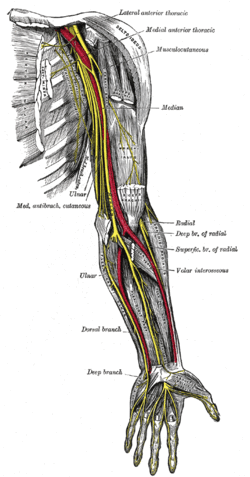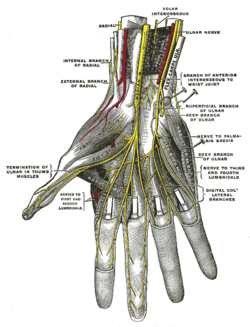- Anterior interosseous nerve
-
Nerve: Anterior interosseous nerve 
Nerves of the left upper extremity. (Volar interosseus labeled at center right.) 
Deep palmar nerves. (Volar interosseous labeled at center top.) Latin nervus interosseus antebrachii anterior Gray's subject #210 938 From Median nerve The anterior interosseous nerve (volar interosseous nerve) is a branch of the median nerve that supplies the deep muscles on the front of the forearm, except the ulnar half of the flexor digitorum profundus.
It accompanies the anterior interosseous artery along the anterior of the interosseous membrane of the forearm, in the interval between the flexor pollicis longus and flexor digitorum profundus, supplying the whole of the former and (most commonly) the radial half of the latter, and ending below in the pronator quadratus and wrist joint.
Many texts, for simplicity's sake, consider this nerve part of the median nerve.
Contents
Innervation
The anterior interosseous nerve clasically innervates 2.5 muscles:
- flexor pollicis longus
- pronator quadratus
- the radial half of flexor digitorum profundus (the lateral two out of the four tendons).
These muscles are in the deep level of the anterior compartment of the forearm.
Injury
A branch of the median nerve, the anterior interosseous nerve (AIN) can be affected by either direct penetrating injury or compression in a fashion similar to carpal tunnel syndrome. The compression neuropathy is referred to an Anterior Interosseous Syndrome. As might be expected, the symptoms involve weakness in the muscle innervated by the AIN including the flexor digitorum profundus muscle to the index (and sometimes the middle) finger, the flexor pollicis longus muscle to the thumb and the pronator quadratus of the distal forearm. As opposed to carpal tunnel syndrome, the AIN has no sensory fibers and therefore no numbness associated with the Anterior Interosseous Syndrome. Non-surgical treatment consists of splinting, proximal tissue massage and anti-inflammatory drugs. Surgical treatment consists of releasing the compression on the nerve from surrounding structures. Pronator Syndrome is similar, but involves both the AIN as well as the median nerve proper.
See also
External links
- Duke Orthopedics anterior_interosseous_branch_of_median_nerve
- anterior+interosseous+nerve at eMedicine Dictionary
- EatonHand ner-071
- -2006253539 at GPnotebook - "anterior interosseous nerve palsy"
- Image (see yellow arrow under "Findings")
This article was originally based on an entry from a public domain edition of Gray's Anatomy. As such, some of the information contained within it may be outdated.
Nerves of upper limbs (primarily): the brachial plexus (C5–T1) (TA A14.2.03, GA 9.930) Supraclavicular Infraclavicular musculocutaneous (lateral cutaneous of forearm)
median/lateral root: anterior interosseous · palmar · recurrent · common palmar digital (proper palmar digital)cutaneous: medial cutaneous of forearm · medial cutaneous of arm
ulnar: muscular · palmar · dorsal (dorsal digital nerves) · superficial (common palmar digital, proper palmar digital) · deep
median/medial root: see abovesubscapular (upper, lower) · thoracodorsal
axillary (superior lateral cutaneous of arm)
radial: muscular · cutaneous (posterior of arm, inferior lateral of arm, posterior of forearm) · superficial (dorsal digital nerves) · deep (posterior interosseous)Other Categories:- Neuroanatomy stubs
- Nerves of the upper limb
Wikimedia Foundation. 2010.
